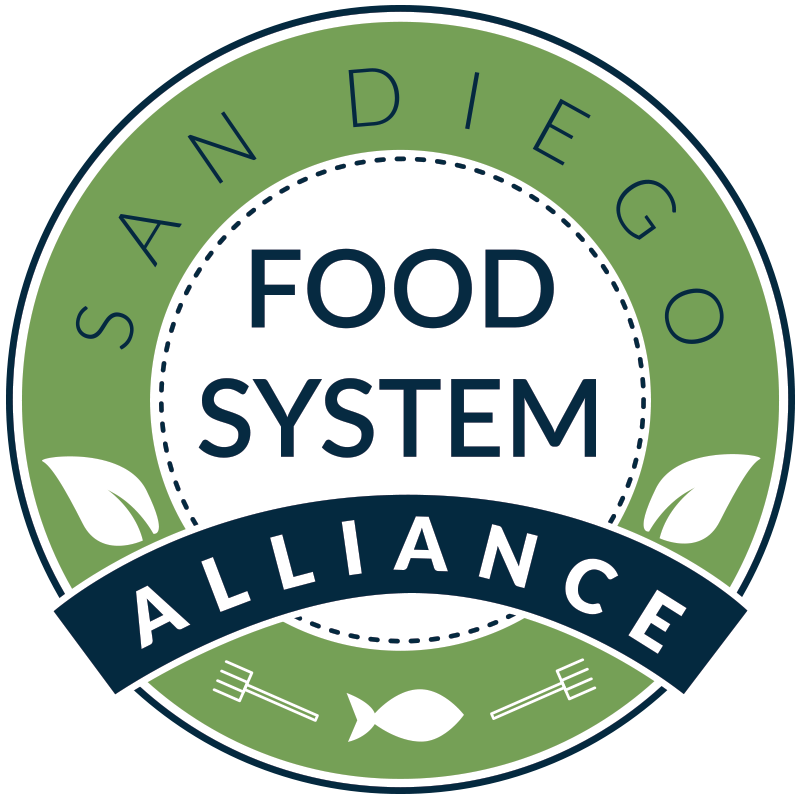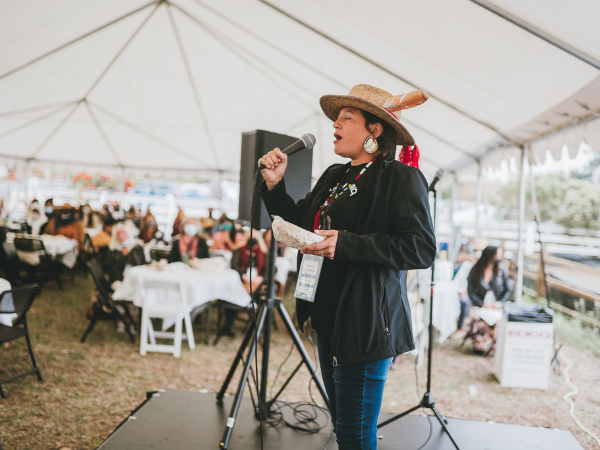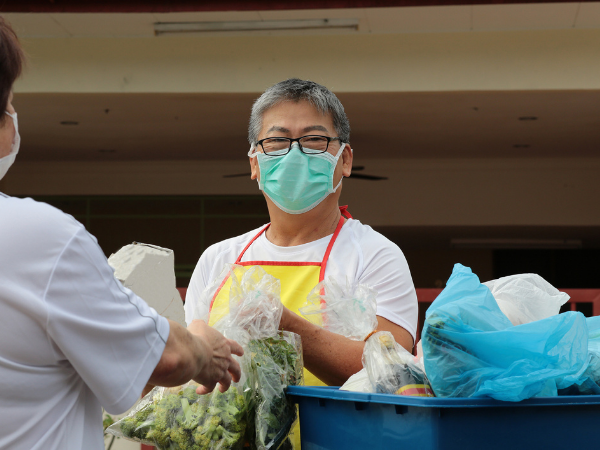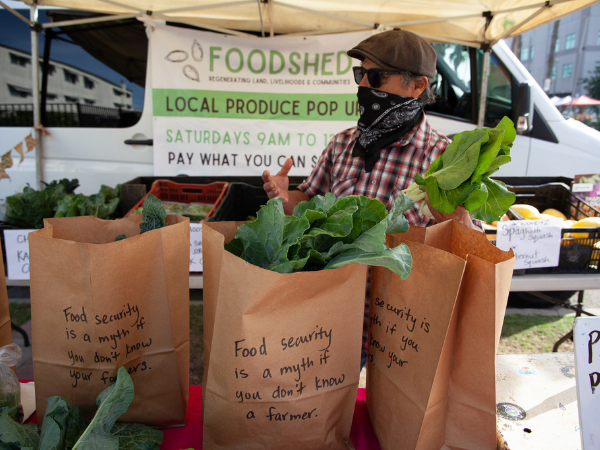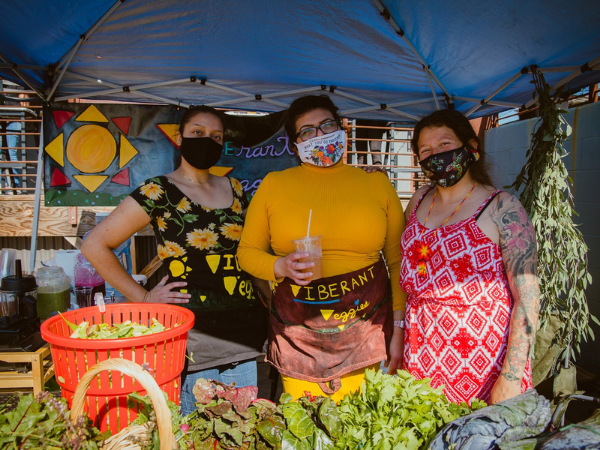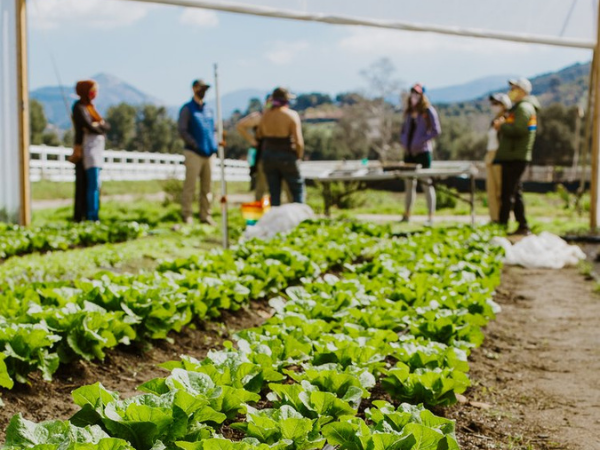The Alliance shapes our work around San Diego County Food Vision 2030.
San Diego County Food Vision 2030 is a shared vision, plan, and movement for transforming our region’s food system over the next ten years. With three goals, ten objectives, and detailed strategies to inform policy, program, planning, and investment opportunities, Food Vision 2030 serves as a call to action and political compass as we work together toward a more equitable and resilient future for all.
Food Vision 2030 was published in the Summer of 2021, and is the work of many people. 3,000 residents of San Diego County—a majority of whom have been deeply impacted by inequities—voiced their needs and aspirations for the food system and provided essential input on the Vision.
“The biggest issue is, how to get food to people who really need the food—and still make a living as a farmer.”
In this 2-minute video, hear from leaders who produce, prepare, distribute, and serve food across San Diego County on why the time to reimagine our food system is now, and why Food Vision 2030 is needed.

Goals & Objectives of Food Vision 2030
Three Goals of Food Vision 2030
The goals of San Diego County Food Vision 2030 reflect the most important challenges of our time—cultivating justice, fighting climate change, and building resilience. Transforming our food system can make inroads in all of these areas. Decisions made about food have a powerful ripple effect in all aspects of society. Changing the way we grow food, move food, share food, and think about food ultimately changes the way we treat the planet and each other.
These goals are linked. We cannot achieve one without achieving the others. And we need to achieve all three to ensure our food system can nourish us today and for generations to come.
-
Increase health, wealth, leadership, and power for BIPOC communities across our food system
Oppression and exploitation have deep roots in our country, beginning with the genocide of Indigenous people and further with the enslavement of Black people. This legacy, along with centuries of discriminatory policies, has been institutionalized in all aspects of our society and continues to marginalize Black, Indigenous, and people of color, creating significant health disparities, continued exploitation of labor, and barriers to opportunity and ownership.
In the food system, healthy food access, food and farm labor, and land and business ownership are all divided along racial lines. Communities of color experience the highest rates of poverty, food insecurity, and diet-related illness. In the U.S., Hispanic/Latinx people comprise nearly 80% of farmworkers, receiving extraordinarily low wages, having few labor protections, and working under heavily compromised conditions on a regular basis. And farmers of color experience significant disparities in land and business ownership, comprising less than 10% of farmland ownership and receiving less than 2% of farm sales.
Through Food Vision 2030, we have an opportunity to reverse these trends. We can elevate opportunities for healthy food access, ownership, and power across Black, Indigenous, and people of color in San Diego County. We can create a more just food system, one that belongs to all of us.
-
Mitigate climate change impacts and adapt to the changing climate in the food system
Climate change is having a devastating impact across the globe. The amount of carbon dioxide in the atmosphere is increasing, the planet is warming up, sea levels are rising, and extreme weather is now commonplace. All of these shifts are dramatically impacting people, the planet, and our economy.
One of the greatest impacts of climate change is connected to how we grow, move, eat, and waste food. Our industrial food system relies heavily on energy from fossil fuels, synthetic pesticides and fertilizers, and monoculture farming. It also produces a significant amount of waste. As a result of these practices, human health, soil health, and environmental health have been degraded for nearly a century. These same practices continue to accelerate climate change, causing droughts, fires, and other extreme weather patterns, and threatening farmer livelihoods and food security. The global food system today is one of the largest contributors to climate change, generating one-third of all greenhouse gas emissions.
Through Food Vision 2030, we have an opportunity to reimagine our relationship with nature and realize that food deeply intersects with climate change. We can invest in climate-smart agriculture, carbon sequestration, plant-rich diets, zero waste initiatives, indoor food production, and community-based food systems in San Diego County. We can fight climate change and create a more sustainable food system.
-
Increase integrated nutrition and food security and create an adaptive local food economy
Resilience is a response to rising levels of insecurity, complexity, and vulnerability in our lives. It refers to our collective ability to respond and recover from adverse conditions, including natural disasters, public health crises, acts of violence, economic hardship, consolidation of power, and cultural loss. It also reflects the capacity of people and communities to heal and rebuild the systems that create and perpetuate vulnerabilities in the first place. Today, there is a growing recognition that the severe and widespread impacts of continuous shocks, threats, and crises are compromising community resilience and our collective survival.
In the food system, industrial agriculture, long supply chains, and consolidation of power have been common since the 1950s. Today, 20 percent of farms control nearly 70 percent of US farmland, four meatpackers slaughter 85 percent of beef, and four companies control 63 percent of the retail market. This consolidation of power has always compromised the health and sustainability of people and the planet. Now, in the face of increasing natural disasters, public health crises, and growing inequalities, the highly concentrated industrial food system is exposing deep vulnerabilities and threatening the resiliency of people, cultures, livelihoods, and ecosystems.
Through Food Vision 2030, we have an opportunity to better prepare for and adapt to shocks in our food system. We can cultivate diverse local and regional economies and build shorter, fairer, and cleaner food supply chains. We can build stronger safety nets. We can heal relationships with the earth and one another. We can create a diverse and resilient food system that is capable of nourishing us today and for generations to come.
Ten Objectives of Food Vision 2030
In addition to the three goals, San Diego County Food Vision 2030 is organized into ten objectives, which serve as a framework for guiding our region as we work together to transform our food system. These ten objectives are our calls to action over the next decade.
-
Farmers, fishermen, and other producers are the backbone of our food system. We depend on them. We also depend on the land, soils, and marine resources that form the foundation of our food supply. In San Diego County, however, land in agriculture, acreage in fruit and vegetable production, the number of farms, commercial fisheries landings, new and beginning farmers and fishermen, and the diversity of producers are all low or in decline. Challenges to sustaining food production in the region include development pressure, the changing climate, the challenge of making a living, limited support services, increasing costs of water, high barriers to entry especially for produces of color, and more.
Land and oceans are vital for life. As stewards of these resources, farmers, ranchers, and fishermen play an essential role in feeding local communities, protecting our natural environment, and fighting climate change. In San Diego County in particular, we have some of the most responsible land and sea stewards in the country. Preserving agricultural land and soils, supporting farmers, fishermen, and other producers, and investing in long-term food production in San Diego County will be essential to securing a thriving, local, and resilient food supply for today and decades to come.
Strategies at a Glance
Scale up agricultural land conservation efforts
Develop an agricultural land trust
Expand climate-smart agriculture
Support coordinated efforts and collaboration to create a technical assistance & business assistance network for farmers and fishermen
-
Small and midsize farmers, fishermen, and food business owners—including food processors, food manufacturers, restaurants, and retailers—struggle to make a living and maintain viable businesses in a food system that does not uplift them. They compete against large corporations for access to markets, and manage operating and labor costs on thin margins. On top of working long hours, they also manage essential tasks like business planning, securing capital, and navigating permits and regulations. Finally, they must pivot their businesses with changing conditions, such as those caused by climate change and COVID-19.
At the root of many viability challenges is market concentration. Multinational corporations dominate the food supply in every region of the United States, including San Diego County. They hold enormous power, resources, and scales of production to drive prices down and squeeze competition out at every phase of the food chain. With their outsize resources, corporations also have immense power to influence consumer preferences. In spite of the growing popularity of slogans like “vote with your fork,” consumer demand for convenience and affordability continues to rise, prompted by corporate retailers’ promises to deliver more, faster, and cheaper. This exacerbates viability challenges for small and midsize businesses, leading to closures and accelerating market concentration trends.
Building a more resilient food supply and economy means we need to ensure that through small business ownership, diverse entrepreneurs are able to increase their income potential, achieve long-term financial stability, provide for their families, and continue enriching their communities. We need to create an integrated support system and invest in those in our community for whom traditional business development services are out of reach, with a focus on BIPOC, immigrants, women, and individuals with low income.
Strategies at a Glance
Support coordinated efforts and collaboration to increase the viability of local food businesses
Expand food system business support services
Encourage creative farm and fishery viability models
Increase community wealth building opportunities across the food system
Create peer-to-peer learning and networking opportunities
-
The dominant food supply chains in America move trillions of pounds of food over thousands of miles, to feed millions of people. Shockingly long, based on mass production, and controlled largely by a small group of corporations, they create distance between producers and consumers, suppress biological and cultural diversity within food systems, accelerate market concentration, and dispossess communities of their food sovereignty. They also push prices down for producers and generate significant waste. Most regions of the country, however, including San Diego County, have become reliant on these global and national supply chains to feed their communities.
Building shorter food supply chains comprised mostly of local producers and food businesses provides a more sustainable and equitable alternative to the dominant way of moving food. It also creates opportunities for San Diego County’s small and midsize producers to capture a greater share of the consumer dollar, connect with local markets, and feed local residents. To create a healthier, more sustainable, and more just food system in San Diego County, we need to invest in our small and midsize producers and local food businesses, as well as the infrastructure needed to store, aggregate, process, distribute, and market their products within our region.
Strategies at a Glance
Invest in aggregation, processing, storage, distribution, and marketing infrastructure
Develop producer collaboratives and food hubs
Increase local, sustainable, and equitable procurement by restaurants and retailers
Leverage the purchasing power of institutions
-
Food system workers are the backbone of our food economy. They keep us fed and are essential for life. A food system that treats its foundational workforce as essential, skilled, and valuable—and compensates workers so that they may thrive—can create fulfilling jobs, reduce job turnover, increase families’ economic security and consumer spending, develop responsible businesses, forge a creative and competitive market, grant low-income communities sovereignty to revitalize neighborhoods and restore land, and reduce healthcare and public assistance costs.
Recognizing the true cost of undervaluing essential labor has never been more important. Lifting wages for all food system workers, improving working conditions, and creating equitable and dignified pathways for career advancement, greater equity, and business ownership is vital in San Diego County.
Strategies at a Glance
Support coordinated efforts and collaboration to improve the lives of food system workers
Invest in food system jobs and career pathways
-
The causes of food and nutrition insecurity are rooted in poverty and segregation. Ultimately, capitalism, structural racism, and our industrial food system perpetuate the food and nutrition insecurity that we see today. As long as essential, life-sustaining resources like land, water, food, and housing are extracted for profit rather than shared for wellness, people will experience poverty, racism, extraction, and food and nutrition insecurity.
As essential as they are, many food access programs that close the meal gap for millions each day are disparate, siloed, and serving federally subsidized, unhealthy food. In contrast, an integrated nutrition and food security system calls for a shift to address hunger in a way that leans on collaboration, elevates healthy and culturally appropriate food, and is designed to reach people where they are. The strategies below are short-term priorities; however, increasing long-term economic security for all and dismantling racism are equally vital.
Strategies at a Glance
Support coordinated efforts and collaboration to expand integrated nutrition and food security
Strengthen federal nutrition assistance programs
Strengthen local charitable food system
Invest in comprehensive food education in schools
Institutionalize food as medicine
Increase long-term economic security
-
There is a strong relationship between food, health, and place. The built environment around neighborhoods shapes the availability of food and the overall health of residents. Communities with limited healthy food options need more than just healthy options in stores—they need an influx of resources and financial support, along with increased ownership of land and capital, to truly transform conditions and overall health.
Improving community food environments requires an intersectional approach that uproots racism, segregation, disinvestment, and poverty. This work must center residents’ aspirations and build community power. Acknowledging and preserving the life, traditions, values, and potential of diverse communities and promoting food sovereignty must be the centerpiece of any attempt to improve community food environments.
Strategies at a Glance
Support coordinated efforts and collaboration to improve community food environments
Expand land use policies and economic development incentives to encourage local food production and healthy food retail
Support the case for reparations
Promote food sovereignty
-
Food waste occurs at every step of the supply chain, with the root cause traced back to concentration within the marketplace. Our industrial food system moves large quantities of food along lengthy supply chains that create distance between producers and consumers. Long, consolidated supply chains have made it difficult to adapt to shifting market demands, and have also created unrealistic cosmetic standards for food. The widespread perception of food as a commodity has also led to an overall culture of waste and prompted wasteful habits at home. Consumers are by far the greatest food waste generators across the entire food supply chain.
Fortunately, momentum has been building in San Diego County to prevent food waste and increase food recovery—diverting edible food from landfill—in the region. Several organizations committed to overcoming challenges in food waste prevention, recovery, and recycling have already advanced working solutions. Moving forward, there is tremendous opportunity to organize and scale up these efforts.
Strategies at a Glance
Coordinate efforts and collaboration to scale up food waste prevention, recovery, and recycling
Enable consumers to more easily minimize household food waste
Expand food waste prevention technical assistance
Scale up food recovery logistics
Support upcycling entrepreneurs
Increase food waste recycling efforts at all scales
-
Our country’s founding ideals and folklore have always been in conflict with its reality. American progress was only made possible by genocide, slavery, and theft of land and labor. Today, most owners of farms, food businesses, and land are White, while farm and food workers are predominantly people of color. Black, Indigenous, and people of color (BIPOC) disproportionately live in neighborhoods with limited healthy food options, and are more likely to suffer from diet-related illnesses such as diabetes and obesity. Wealth and power across both public and private sectors are held by a White majority, while people of color have limited economic opportunity and agency.
The White-dominant culture that allowed this segregation to take root is also responsible for creating the industrial food system that erodes our environment, local economies, and health. Many concepts now gaining popularity as sustainable and equitable alternatives—including organic farming, regenerative agriculture, CSAs, cooperatives, community land trusts, and food sovereignty—can be traced back to food justice leaders of color. Living in harmony with nature, honoring ancestral wisdom, sharing prosperity, and using the Earth’s resources in a way that is mindful of other species and future generations are cultural values deeply held and long practiced by communities of color, particularly Indigenous communities. Excluding them from leading the way has cost us dearly.
Dismantling racism and increasing wealth, power, and leadership opportunities for Black, Indigenous, and people of color is essential for creating a more equitable and resilient food system. As those who are most directly impacted by inequities across our food system, it is time to listen to them, respect their wisdom, and follow their lead.
Strategies at a Glance
Increase community-led food system planning & policy efforts
Elevate voices of BIPOC people, places, and programs
Diversify food system leadership and Invest in BIPOC leaders
Democratize funding decisions
-
Unsurprisingly, the most heeded and well-funded movements calling for healthy and sustainable food have been dominated by those who have had the most wealth, representation, and power in the food system. The results, therefore, have revolved around using wealth and consumer power to create special markets for food deemed by this group as healthy, sustainable, and ethical.
Creating escapes from the industrial food system—for those who can afford to participate—does not address its larger issues of deepening injustice, accelerating climate change, and weakening resilience. As the nation confronts the pandemic, climate crisis, increasing economic inequality, and entrenched racism, many are realizing that fixing our systems requires deeper reflection and a profound examination of power. To borrow words from Beatriz Beckford, longtime organizer for the National Black Food and Justice Alliance, “It is critical that anyone engaged in the food movement—or any movement for that matter—have a racial justice analysis and further, a racial justice practice. Any movement devoid of that practice is not a movement at all.”
Cultivating a true movement for food system transformation that creates common ground for diverse efforts, centers those most impacted, and ultimately, includes everyone, requires extensive social, economic, political, and tactical organization—not to mention significant funding and deep relationship-building.
Strategies at a Glance
Support coordinated efforts and collaboration to build a local, sustainable, and equitable food movement
Reconnect urban and rural communities
Increase food system education and storytelling
Build community power
-
Our future is uncertain, and the resiliency of people, cultures, livelihoods, local economies, and ecosystems are all being threatened. For decades, our highly concentrated and industrial food system has been compromising the health and sustainability of people and our planet. Now, in the face of increasing natural disasters, public health crises, and growing inequalities, our food system is showing deep vulnerabilities and testing our resilience.
Planning for a resilient food system in San Diego County will require increased coordination and collaboration. In the short-term, it will be essential to create food system resilience plans that prepare us for future crises, cultivate working partnerships with Indigenous and other marginalized communities—who embody resilience socially, culturally, psychologically, spiritually, and often ecologically—strengthen our local food economy, and develop bold, flexible, and lasting sources of funding. In the long-term, however, building resilience will require a complete transformation of how we live and relate to one another and our environment.
Strategies at a Glance
Support coordinated efforts and collaboration to build a resilient food system
Partner with Indigenous communities
Create food system resilience plans
Strengthen the local food economy
Develop bold, flexible, and lasting sources of funding
Our Approach
Developed over two years, the Vision is deeply rooted in research and the needs and aspirations expressed by our community. Our process included comprehensive literature review, in-depth analyses, hundreds of hours of interviews, several focus groups, and broad community engagement.
To develop the Vision, we created an inclusive process that engaged the full community, including people who produce, prepare, distribute, serve, and eat food. Our goal was to build a shared vision—one that includes voices from the public, private, and philanthropic sectors in addition to community members, particularly those most affected by current inequities in the food system.
Learn more about our approach on the Food Vision 2030 website.

San Diego County Food Vision 2030 is led by the San Diego Food System Alliance—including our Staff, Board of Directors, Food Vision 2030 Stewardship Committee, and Community Partners—and supported by the San Diego County Board of Supervisors.
To support and learn more about those who have been intimately involved in crafting this common agenda, please visit the Stories and Acknowledgments pages on the Food Vision 2030 website.
